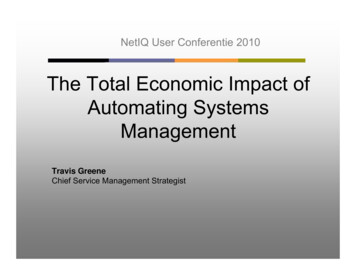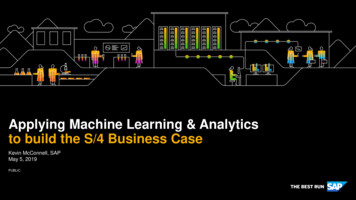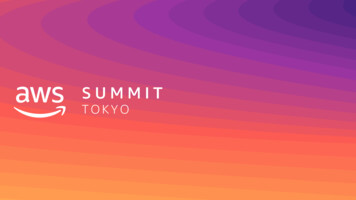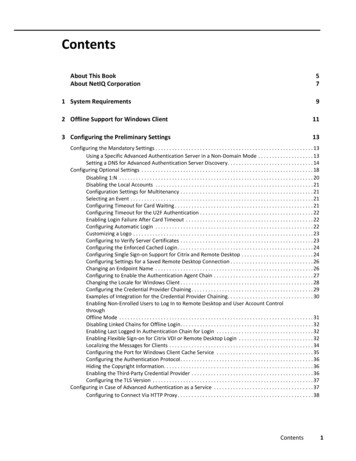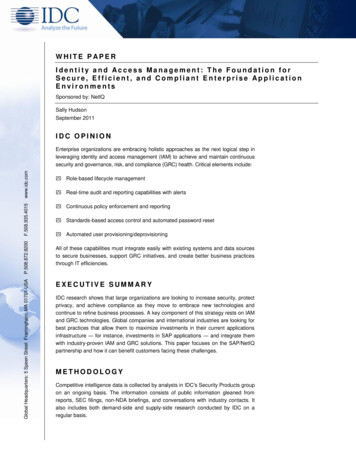
Transcription
WHITE P APERIdentity and Access Management: The Foundation forSecure, Efficient, and Compliant Enterprise ApplicationEnvironmentsSponsored by: NetIQSally HudsonSeptember 2011IDC OPINIONGlobal Headquarters: 5 Speen Street Framingham, MA 01701 se organizations are embracing holistic approaches as the next logical step inleveraging identity and access management (IAM) to achieve and maintain continuoussecurity and governance, risk, and compliance (GRC) health. Critical elements include: Role-based lifecycle management Real-time audit and reporting capabilities with alerts Continuous policy enforcement and reporting Standards-based access control and automated password reset Automated user provisioning/deprovisioningAll of these capabilities must integrate easily with existing systems and data sourcesto secure businesses, support GRC initiatives, and create better business practicesthrough IT efficiencies.EXECUTIVE SUMMARYIDC research shows that large organizations are looking to increase security, protectprivacy, and achieve compliance as they move to embrace new technologies andcontinue to refine business processes. A key component of this strategy rests on IAMand GRC technologies. Global companies and international industries are looking forbest practices that allow them to maximize investments in their current applicationsinfrastructure — for instance, investments in SAP applications — and integrate themwith industry-proven IAM and GRC solutions. This paper focuses on the SAP/NetIQpartnership and how it can benefit customers facing these challenges.METHODOLOGYCompetitive intelligence data is collected by analysts in IDC's Security Products groupon an ongoing basis. The information consists of public information gleaned fromreports, SEC filings, non-NDA briefings, and conversations with industry contacts. Italso includes both demand-side and supply-side research conducted by IDC on aregular basis.
IN THIS WHITE P APERIn this white paper, IDC outlines the particular advantages of an identity-driven,holistic approach to achieve security, efficiency, and compliance within the enterprise,with a specific focus on NetIQ (formerly Novell) SAP environments.SITUATION OVERVIEWEnterprise IT departments face escalating security and operational challenges.The majority of these challenges are posed by continual fluctuations in information,identities, and access points. This threat vector is created by distributed andmobile computing, increased consumerization of IT, and increased threats frominternal and external sources. To combat these threats, organizations must coalignsecurity and identity with GRC initiatives and update and review these areas on acontinuous basis.Enterprise organizations must also focus on meeting the demands of governmentand industry regulations. Today, these demands include the Health InsurancePortability and Accountability Act [HIPAA], the Gramm-Leach-Bliley Act [GLBA],the Sarbanes-Oxley Act [SOX], CobiT, ITIL, the European Union's DPD (EU DPD),Solvency II, EU Directives 136 and 140, Japan's JPIPA, and PCI DSS, among manyothers on an ever-expanding, international list. IDC research shows that Europeanregulations on privacy and PCI DSS will continue to be implemented, will be moreenforced by financial institutions or regulators, and will be more visible to the public.In addition to audit and certification, compliance is also monitored by regulatorybodies such as ICO (United Kingdom), CNIL (France), and AEPD (Spain) for privacyregulations. While all of these regulations have different specifications, they do havecentral themes in common: The regulations are designed to guarantee that only thepeople who should have access do have access to data and information.Although cumbersome and complex, these regulations are necessary to help guardagainst loss and/or leakage of intellectual property, customer information, and highlysensitive content. It is critically important that governments and commercialcorporations be able to certify that access control and access to information arecontinually monitored, enforced, and tracked for all entities accessing the system,from both inside and outside the company. This is essential to guarantee security,meet compliance, and assure customers and regulators that sensitive information issafe from misuse and corruption.Identity and access management is the foundation technology used by organizationsto build secure and compliant business processes and access control policies.MARKET AND TECHNOLOG Y TRENDSIdentity and access management is the who, what, where, when, and why ofinformation technology. It encompasses many technologies and security practices,including secure single sign-on (SSO), user provisioning/deprovisioning,authentication, and authorization. Over the past several years, the Fortune 2000 andgovernments worldwide have come to rely on a sound IAM platform as the foundation2#230278 2011 IDC
for their GRC strategies. This is borne out by the numbers: IDC research shows thatthe IAM market accounted for almost 4 billion in license and maintenance revenue in2010, and we estimate that 80% of these sales were directly driven by the need tomeet regulatory compliance mandates.This lays the foundation for the larger GRC infrastructure for the enterprise, an areawhere companies such as SAP and NetIQ (and Novell before it) have combined yearsof experience and expertise. IDC defines GRC infrastructure as focusing on solutionsthat provide policy and workflow definition; documentation; policy enforcement andoperationalization; and monitoring, testing, and verification of controls at the ITinfrastructure layer. It is an ongoing, dynamic process. As more organizationsdecentralize with branch and home offices, remote employees, and the consumerizationof IT, the need for strong security and GRC practices is greater than ever.As the number of highly publicized IT security breaches grows, the demand for moredetailed audits and reporting requirements within organizations increases as well.This creates painstaking and time-consuming challenges for IT and businessprofessionals required to perform the logging, reporting, and audit point processesnecessary to meet SOX, GLBA, PCI DSS, EU DPD, Basel II, ITIL, CobiT, and themyriad of other regulations. The challenges extend to include access control, systemsintegration, transparency, automation, and remediation. Without the proper tools, thetask soon becomes overwhelming and prone to mistakes, oversights, and deliberateshortcuts within companies.IDC's position is that there is no single technology capable of solving all the security andcompliance needs of an organization. To this end, IAM is increasingly used inconjunction with secure information and event management (SIEM) and GRC softwareto provide a comprehensive and holistic approach to enterprise security andcompliance. SIEM solutions include software designed to aggregate data from multiplesources to identify patterns of events that might signify attacks, intrusions, misuse, orfailure. Event correlation simplifies and speeds the monitoring of network events byconsolidating alerts and error logs into a short, easy-to-understand package.Implementing an IAM/SIEM/GRC infrastructure is not a do-it-and-forget-about-it processfor IT because it involves an ongoing relationship with Human Resources and businessmanagers. After discovery has taken place, roles have been defined, and accessprivileges have been granted or revoked based upon job function and division,ultimately these transactions must be validated and certified as being in compliance withpolicy and regulations. The ability to automatically pull access, control, and data usageinformation from various system sources and generate timely exception reports to bematched against policy is highly appealing to most corporations.NetIQ and SAP: Synergies for IdentityInfusion in the EnterpriseFollowing the Novell acquisition in April 2011, the legacy Novell identity, security, andcompliance products are now sold under the NetIQ brand. NetIQ currently boasts acustomer base of over 6,000 identity and security customers worldwide. It is focusedon providing customers with solutions to securely deliver and manage computingservices across physical, virtual, and cloud computing environments. NetIQ has built 2011 IDC#2302783
strong momentum through its industry-proven identity-based security solutions and itsexpanded partner ecosystem — two key components for future growth. Every yearstandards are amended and refined, and organizations must continually scramble tokeep pace with the evolving nature of regulations. NetIQ has architected its identityand security management products to respond to situations in real time. The goal is toallow customers to act/react in a matter of seconds versus a matter of days and tocorrect problems in real time rather than on a reconciliation basis. This is a keydifferentiator in NetIQ's approach. IDC research has shown NetIQ to be a consistentworldwide market leader in IAM software solutions.SAP, the international software giant based in Walldorf, Germany, has 53,000employees worldwide and a customer base that exceeds 109,000, spanning allindustries in over 120 countries. It is the largest ERP vendor in the world. As of early2011, SAP reported a community of 2,400 partners worldwide. Part of the company'sgrowth strategy includes co-innovation with partners, driven by ongoing investmentsin the partner ecosystem. IDC expects that most of this co-innovation will leverageexisting partners and strategic acquisitions rather than a significant expansion of thepartner community.The legacy Novell/SAP relationship flourished for more than a decade. It began in1999 when the companies initiated a Linux partnership and then expanded to includeeDirectory in 2002. In 2009, Novell's IAM software achieved integration certificationwith SAP BusinessObjects business analytics software and SAP NetWeaver adaptivemiddleware for information and business process management across the enterprise.The legacy Novell, and now NetIQ, identity and security technologies are SAPcertified on both platforms. There are currently 2,500 mutual clients. This partnershipallows NetIQ to address a number of challenges that SAP application owners and ITdepartments are facing today, including:A constantly changing user population that needs access to SAP applications hostedinternally, on the Web, and in the cloud Giving users appropriate access; provisioning them quickly to provideproductivity (This is time consuming and labor intensive — especially if there aremultiple instances of SAP applications to manage.) Providing appropriate access without compromising security SIEM for monitoring and remediating security and compliance eventsAs part of this effort, NetIQ's software solutions portfolio currently provides SAPcustomers with the following:The NetIQ Identity Framework: A Single, Integrated BackboneThe NetIQ Identity Framework comprises the following components: Identity Manager 4 Advanced Edition. This software is capable of automatingand managing literally thousands of user identities both inside and outside theenterprise. It enables complete control over the management, provisioning, anddeprovisioning of identities in physical, virtual, and cloud environments. It can4#230278 2011 IDC
extend enterprise-compliant processes to SaaS applications securely and withsustainability and ensure that enterprise security policies are consistent acrossbusiness domains. Identity Manager provides comprehensive, activity-levelreporting on who has access to what and offers business-friendly user interfacesthat map seamlessly into existing user interfaces. Importantly, it adapts to thecustomer environment (e.g., SAP NetWeaver) so that customers can retain theirexisting policies while adding intelligence for alerts when proposed changesconflict with current policy infrastructure. Sentinel. This product provides organizations with real-time visibility andintelligence into IT events to mitigate security threats, improve security operations,and enforce policy controls across physical, virtual, and cloud environments.Sentinel leverages the Identity management suite to deliver industry-proven useractivity monitoring capabilities by tying users to specific events and quicklyidentifying critical threats. Sentinel can easily detect anomalous activities in adistributed or traditional IT infrastructure to speed remediation and build a strongsecurity foundation. As an identity-aware security intelligence solution, Sentinel iswell-equipped to address the advanced threat environment, improve operationalefficiency, and streamline regulatory compliance processes. Access Manager. This software implements industry standards–basedfederation capabilities to give users a secure way to pass authenticationinformation across domains. The software enables straightforward access toemployees, customers, and partners using standards-based accessmanagement technologies that make it easy to securely share identityinformation across business and technical boundaries.Access Governance SuiteThis suite comprises three critically important components: Access Certification. This component includes the Compliance CertificationManager (CCM) and provides a complete, enterprisewide view of user accessdata so that organizations know exactly who has access to what. This isinvaluable in preventing abuse and security breaches. Data is collected acrossmanually provisioned, help desk–provisioned, and automatically provisionedsystems. CCM ensures that user access to resources is appropriate andcompliant with policies. CCM also streamlines review, certification, and reportingvia automated processes, which reduces the risk associated with manualchanges and reviews. It manages the entitlements associated with usersthroughout the user lifecycle, including when internal and external users join,move within, and leave the enterprise. Role Lifecycle Management. This software allows the review of access rightsacross automatically provisioned, help desk–provisioned, and manuallyprovisioned systems. Roles Lifecycle Manager simplifies how user access ismanaged on a periodic/quarterly basis, giving visibility to patterns and logicalgroupings. This simplifies access change management and compliance. RolesLifecycle Manager simplifies the process of making sure access rights areappropriate and provides access metrics to ensure that roles are used effectively. 2011 IDC#2302785
Access Request and Change Management. This component provides a selfservice portal for the business and simplified mechanisms for granting accessrequests. The Access Request and Change Manager provides a single businessfriendly interface with embedded governance (approvals, policy checks,escalations) through which IT professionals and/or line-of-business (LOB)managers can request and approve access rights. By enabling self-serviceaccess requests to the line of business, organizations can lower IT administrationcosts and streamline access delivery while maintaining compliance.All of these products have been optimized to work within SAP enterpriseenvironments and provide increased security, business efficiency, and the ability tomeet detailed and granular compliance audits. Enterprise IT sites that rely on SAPsoftware constitute a multibillion-dollar worldwide market today (see Figure 1).FIGURE 1Worldwide SAP Direct and Indirect Revenue Share for AllSoftwareIndirect (16.7%)Direct (83.3%)Total 13.3BNote: Data provided is estimated.Source: IDC, 2011The capabilities of the NetIQ/SAP platforms are illustrated by the following case study.Customer ProfileCGT (Compagnia Generale Trattori)CGT, based in Milan, is the official dealer of Caterpillar machinery and engines inItaly. CGT sells the entire CAT range of earthmoving and mining machinery, dieselengines, and industrial gas turbines. The company also provides value-add servicesto its clients, including technical assistance and parts, rental of machines, and resaleof used equipment.6#230278 2011 IDC
ChallengeWith approximately 1,300 employees across 41 branches, CGT was finding itchallenging to manage user identities and access rights across dozens of differentcorporate applications and databases. CGT had merged with another company toextend coverage to all of Italy, creating a company where 1,100 people wereaccessing the IT systems each day. To maintain security, create appropriate rolesand access controls, and improve business processes, CGT needed to implement anautomated user provisioning and deprovisioning system.The company relies on SAP for all financial, sales, and human resource applications; onlegacy iSeries for service and parts management; and on many applications deployed onLotus Domino and legacy systems based on Oracle Database. Prior to theimplementation of the NetIQ technology, updating a user's profile to reflect a change inpersonal information or to provide access to new applications was a manual process thatrequired significant effort from the IT department because of the many different userdirectories. This created delays and left the business frustrated that its requests couldtake several days to execute. Equally, users were required to spend significant amountsof time logging in and out of systems, causing further frustration and inefficiency.SolutionAfter evaluating several potential solutions from leading vendors in the IAM space, CGTdecided to implement NetIQ Identity Manager, Access Manager, and SecureLogin.The ability of the NetIQ solutions to work across a broad variety of softwareenvironments — CGT uses the IBM i platform alongside Microsoft Windows and alsohas large Lotus Domino and SAP environments — was a key factor in the decision.According to IT Manager Claudio Passoni, CGT needed a solution that wouldwork with the company's heterogeneous environment and that would also provideprebuilt connectors to standard enterprise software such as SAP, iSeries, andLotus Domino. To design, implement, and roll out its new identity and securitymanagement solution, CGT worked with three external partners. Unisys Italia was thelead partner and project coordinator, while Aglea handled the required modificationsto CGT's SAP solutions. Net Studio was the principal implementation partner for theNetIQ technologies.CGT was struggling to manage updates to employee profiles and access rights in atimely and efficient way. By selecting Identity Manager and Access Manager fromNetIQ, the company has improved the speed and efficiency of identity management,enhanced security, and ensured that IT is more responsive to requests fromthe business and promptly aligned with organizational change. At CGT, the SAPinstallation is in four different directories across the company, creating a problem withthe manual provisioning process from a time and accuracy perspective. The NetIQsoftware is allowing CGT to implement an automated roles-based access controlsystem. This not only saves time and improves security but also allows the companyto automate the attestation process to meet compliance rules and privacy regulations."The rules are being designed to reflect intercompany interactions," said Passoni,noting that CGT is working to build common base profiles, which will allow businesschiefs to assign roles appropriate to each user and transaction. 2011 IDC#2302787
CGT is also using SecureLogin to provide single sign-on capabilities to users acrossthe network.ResultsPassoni and his team give NetIQ products high marks for ease of use andimplementation. Using the Identity Manager and Access Manager solutions, CGT has: Created a single central repository for all user identity information Simplified and accelerated the setup of new users, saving time and effort Automated authorization updates due to organizational change Extended authentication over the Web, facilitating logins from remote locationsCGT and its partners are now rolling out the new NetIQ solutions across the entirecompany. Identity Manager acts as a central point of control over user identities thatwere previously managed in dozens of different directories and applications. AccessManager enables the company to extend authentication seamlessly over the Web,simplifying and securing remote work through enterprise portals. The deployment ofIdentity Manager has accelerated and largely automated the provisioning of new useraccounts at CGT, reducing delays for employees and cutting the workload for the ITdepartment. "With Identity Manager, we can create automated workflows to provisionnew users when they are created in the SAP Human Resources solution," saidPassoni. "Setting up new users takes a matter of minutes, and when we makechanges to user information, they are automatically synchronized across allconnected directories and systems — so the NetIQ solution saves us significantamounts of time and effort."FUTURE OUTLOOKAs companies embrace newer (e.g., mobile, cloud) technology to improve economiesof scale and reduce operational expense, security and compliance issues willcontinue to be top of mind for C-level executives. All areas of IAM contribute to accesscontrol and compliance, including advanced authentication, Web SSO/federated SSO(WSSO/FSSO), enterprise SSO (ESSO), user provisioning, personal portable securitydevices, SIEM, and access governance. Secure access control is critically importantbecause corporations and other entities must be able to track and report on "who hadaccess to what when" and what they did with the data once they were there. Even if acompany contracts with a cloud service provider, it is not exempt from complianceregulation responsibility.Vendor success in this market will rest largely on partnerships and ecosystembuilding, as identity-driven infrastructure must be used in conjunction with GRCconcerns and systems management capabilities. Again, no single entity has all thenecessary pieces to the compliance and security puzzle. Further, as consumerizationof IT blurs line between professional life and personal life, risk factors multiply yetagain, making the need for holistic and proactive solutions that much more importantfrom a security and GRC perspective.8#230278 2011 IDC
CHALLENGES AND OPPORTUNITIESNetIQ faces strong competition in the enterprise identity space. In the SAP market,this competition primarily comes from industry heavyweights Oracle, IBM, and CATechnologies. Further, newcomers with point solutions in certification and attestationcould take focus away from a holistic solution approach.NetIQ must continue to leverage its longstanding relationship and acquired expertise withSAP customers to demonstrate value. This can be seen through the customerdeployments of easily integrated NetIQ Identity solutions and the realized ROI from theseprojects. Customers are looking for less, not more, complexity when solving complianceand security issues, and NetIQ has a proven track record with SAP in this area.CONCLUSIONEnterprise organizations are leveraging identity solutions to increase security andachieve compliance while enhancing business productivity. SAP customers inparticular can leverage the NetIQ Identity solutions to achieve these goals. Using theSAP-certified NetIQ Identity and Access Management and Access Governancesoftware, SAP customers can realize benefits by: Easily integrating and protecting existing SAP investments Saving time and money by automating manual processes Realizing greater ROI in a shorter period of time Redirecting resources to other projectsMost importantly, SAP customers can use identity as a foundation to enhancesecurity and simplify compliance in today's increasingly complex and vulnerable ITenvironment. This identity foundation allows enterprise IT to more easily build outadditional capabilities to keep pace with the changing business and computinglandscape. Importantly, the NetIQ software can be extended to protect enterprisesystems beyond SAP to create a holistic corporate identity foundation.Copyright NoticeExternal Publication of IDC Information and Data — Any IDC information that is to beused in advertising, press releases, or promotional materials requires prior writtenapproval from the appropriate IDC Vice President or Country Manager. A draft of theproposed document should accompany any such request. IDC reserves the right todeny approval of external usage for any reason.Copyright 2011 IDC. Reproduction without written permission is completely forbidden. 2011 IDC#2302789
with SAP BusinessObjects business analytics software and SAP NetWeaver adaptive middleware for information and business process management across the enterprise. The legacy Novell, and now NetIQ, identity and security technologies are SAP certified on both platforms. There are currently 2,500 mutual clients. This partnership


